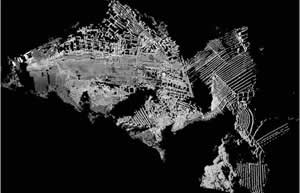In 2005 and 2009, researchers from CAST used the Optech ILRIS-3D laser scanner to scan the ancient ruins of Machu Picchu in Peru. To read more about the survey, please visit the section on Machu Picchu Project Details.
Several data sets from the Machu Picchu survey are available here as point clouds in the Polyworks PWK format (as IMInspect projects) or .obj polygonal mesh.
For the PWK formats we recommend using the free Polyworks | Viewer (previously the Polyworks IM Viewer), and for the obj files we recommend Rapidform Geomagic Verify Viewer (previously the Rapidform Explorer).
To open a PWZIP file – click on the .pwzip link below and save the file; if you are using Mozilla Firefox, right click on the link and save the file. Open IMView, left click on “File” at the top of the screen. Select “Open project”, then “Add Workspace” and browse to the .pwzip’s saved location. Next, choose a local location to extract the files. The files will unzip and the project will appear in IMView’s workspace file structure. Left click on the project and open.
MP_entiresite.pwzip (228 mb)
Collected 2005
MP_entiresite.pwk represents the complete Machu Picchu data set consisting of 8 merged scans. The data were acquired over a period of four nights at 3 – 20 cm resolution resulting in a collection of nearly 30 million data points. For viewing purposes, the data have been reduced here to 8 million points. This particular data set really gives the user a feel of what it is like to“be” at Machu Picchu.
Please note. This data is distributed under a Creative Commons 3.0 License (seehttp://creativecommons.org/licenses/by-nc/3.0/ for the full license). You are free to share and remix these data under the condition that you include attribution as provided here. You may not use the data or products in a commercial purpose without additional approvals. Please attach the following credit to all data and products developed there from:
Credit:
Instituto Nacional de Cultura, Center for Advanced Spatial Technologies, (University of Arkansas) andCotsen Institute for Archaeology (UCLA)
Longer version:
Data developed under the authority of the Instituto Nacional de Cultura, Vladimir Dávila – Arquitecto del P.A.N Machu Picchu, Director del P.A.N Machu Picchu Direccion Regional de Cultura Cusco and Fernando Astete – National Archaeological Park of Machu Picchu. Data acquired, processed and distributed by the Center for Advanced Spatial Technologies staff (Snow Winters, Malcolm Williamson and Katie Simon) and by students in the 2009 Cotsen Institute for Archaeology (UCLA) Cuzco/Machu Picchu Field School, Alexei Vranich Director.

